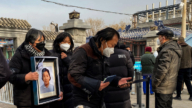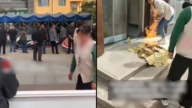【新唐人2014年01月14日讯】中国云南省藏区香格里拉县独克宗古城,周六发生火灾,250多幢房屋被烧毁,2/3的古城化为灰烬,当地调动近2000人,花了10个多小时才控制了大火。评论指出,近年来,中国地方政府为了经济利益,热衷于对古城开发,却疏于对景区火灾等隐患进行防范。
独克宗古城,距今有1300年历史,是中国保存得最好及最大的藏民居群,这个蕴含深厚文化积淀的古城,目前已是一片废墟。
独克宗古城火灾发生于1月11号凌晨,古城里的客栈老板吴女士对《新唐人》表示,古城中下段的“如意客栈餐厅”先着火,报警后,消防车半个小时后才到,结果煤气管道爆炸,导致周边全着火了。
云南藏区香格里拉县独克宗古城客栈老板吴女士:“很多条街都烧了,是木造房子,风一吹就过去了,整片整片都烧了,救火也救不了,也没办法,消防栓都没水,要不然怎么可能一直烧啊,人的话就没什么问题,就是损失财产那些比较严重。”
媒体报导说,总面积1.5平方公里独克宗古城,受火灾面积约1平方公里。大火发生后,当地调动近2000人扑火,10多台挖土机和39辆消防车,10个多小时后才把火扑灭。
迪庆州政府说,初步统计,火灾共造成仓房、金龙、北门等三个社区的335户、242栋房屋烧毁﹔此外,火灾还造成部分文物、唐卡等艺术品烧毁,经济损失至少一亿元人民币。
知名藏人作家唯色表示,这座藏区老城,近年来由于高度商业化,早已摧毁。现在再说它是“古城”有些牵强。
大陆藏人作家唯色:“我想应该没有什么一千多年历史的房子,因为就在这个被烧的区域,周围有一些寺院,寺院也是在文革被砸了,包括香格里拉最大的寺院——松赞林寺,也在文革被砸,文革之后才恢复的、重建的。所以,实际上在这些地方没有什么千年古城。”
唯色说,这座老城在藏语里叫“结唐”,后来改名为“中甸”,2001年当地政府为了迎合旅游的需要,改成了“香格里拉”。
唯色:“它更名为香格里拉以后,这个地方实际上高度商业化,我去过7、8回,我们住在那的时候,我也看到过,那些挨肩接踵的全是各种各样的房子,它的房子都是酒吧、商店、客栈等等,其实所谓古城全是这样的。”
独克宗古城是所谓“茶马古道”上的重镇,2001年被当局批准为云南历史文化名城。时事评论员邢天行指出,中共打着民俗文化的招牌,建立的所谓文化古城,却被商业化了。
时事评论员邢天行:“至于那些安全隐患,许许多多的东西,并不是它要考虑和关注的,表面上它总结的是一亿的经济损失,如果真的是有历史上那些东西存在,它绝对不是这样一个数字,它那个东西是无可估量的损失。”
邢天行指出,这场大火让人痛惜的同时,也在提醒人们,如果只是一味的开发旅游区,不去关注和保护那些真正有着千年文化积淀的古城,中国文化将在商业化过程消失殆尽。
唯色在博客中列举了这一年多来,西藏频频发生的火灾事件。如, 2012年12月29号,四川省藏区新龙县茹龙镇的“则热寺”火灾,烧毁闭关中心及学僧房120多间,佛学院除大殿外全部烧毁。
去年5月4号,也是四川省藏区的白玉县“嘎托寺”火灾,几十间僧舍和部分佛教文物被烧毁﹔11月16号,同样四川省藏区的“理塘寺”也发生火灾,中心大殿被烧毁,部分僧人还因为抢救珍贵文物而受伤。
今年,1月9号,四川省甘孜藏区的“喇荣五明佛学院”火灾,烧毁两百多间房子,有僧尼受伤﹔才事隔两天,11号凌晨,云南“独克宗”老城再度发生火灾。
采访编辑/李韵 后制/李勇
Fire at Shangri-La County Turns Ancient City Into Ash
Saturday’s fire at ancient city Dukezong, Shangri-La County
of the Tibetan Area in China’s Yunnan Province,
burned down more than 250 houses.
Two thirds of the ancient city turned into ashes.
Local authorities mobilized nearly 2,000 people and
took over 10 hours to get the fire under control.
Commentators pointed out that, local government was keen on
developing on the ancient site for financial gains in recent years,
yet neglected to implement procedures for hazards such as fire.
Dukezong has 1,300 years of splendid history.
It is the largest and best preserved ancient Tibetan city.
It is however, a pile of ruins now.
The fire happened in the early hours of Jan. 11.
Ms Wu, owner of a hotel in the city, told NTD,
“Ruyi Hotel and Restaurant, located at the lower section
of the city caught fire first.
“Fire trucks arrived 30 minutes after the call.
As a result, a gas pipe explosion caused the fire to
spread more rapidly.”
Ms Wu: “Houses on many streets were burned.
All houses were built with wood.
With a little wind, the whole area was on fire.
“There was no way to put the fire out..
There was no water in the water hydrant.
“Else it would not have been on fire for so long.
People are OK though, but there is serious property damage.”
According to the media, about one square kilometer of the
1.5 square kilometers of Dukezong city, was hit by fire.
Local authorities mobilized nearly 2,000 people,
over 10 excavators and 39 fire engines.
It took more than 10 hours to put the fire out.
Government officials in the Diqing Area said, preliminary
statistics indicate the fire affected 335 family’s,
destroying 242 houses in the Cangfang, Jinglong and
Beiben communities.
The fire also caused economic losses of at least 100 million yuan
( approximately US$ 16,547,300), including relics,
thangkas (Buddhist deity paintings on silk) & other works of art.
Renowned Tibetan writer Woeser said, “This old Tibetan town
was already destroyed due to high commercialization.
It is not really an ancient city any more.”
Woeser: “There is not any house with over 1,000 years history.
There are some temples around the burned area.
“They were destroyed during the Cultural Revolution.
Shangri-La’s largest monastery Songzanling Temple, was
smashed during the Cultural Revolution and was rebuilt later.
“So there is no real ancient city with over 1,000
years of history.”
Woeser said, “This old city was called “Jietang" in Tibetan,
later renamed as Zhongdian.
“In 2001 local government changed it to Shangri-La,
in order to meet the needs of tourism.”
Woeser: “It later changed its name to Shangri-La.
This place is actually a highly commercialized area now.
“I visited the area seven to eight times.
There are all kinds of buildings that are hotels, stores & bars.
In fact, all the so-called ancient cities are now like that.”
Dukezong is the so-called important town along the
“Tea And Horse Road."
In 2001 it was approved by the authorities as a
historical and cultural city of Yunnan.
Commentator Xing Tianxing pointed out, the Chinese
Communist Party (CCP) built a commercialized
so-called ancient city, with the banner of folk culture.
Xing Tianxing: “Safety hazards, amongst others,
were not the focus of CCP.
“Reportedly, it caused 100 million yuan of economic loss.
If there really were historical relics in there,
then the cost is innumerable.”
Xing Tianxing: “While mourning over the fire,
we should realize that Chinese culture will disappear
along with the commercialization process.
“If we continue to blindly develop tourist areas instead of
protecting such places,
“the true cultural heritage of over 1,000 years will be gone.”
Woeser cited in her recent blog, frequent fires have occurred
in Tibet in the past year. For example:
Zere Temple fire on Dec. 29, 2012 at Longzhen Xinlong County,
also other areas in Tibet, burning over 120 rooms, including
the retreat center and classrooms.
The Buddhist Institute was totally destroyed except for the hall.
Tibetan Area that
The fire at Gatuo Temple on May 4, 2013 also in the
Tibetan area of Baiyu County,
burned dozens of shag (textiles) & other Buddhist relics.
The fire at Litang Temple on Nov. 16, 2013,
was also in the Tibetan area. It destroyed the central hall.
Some monks were injured whilst they rescued relics.
On Jan. 9, 2014 Sichuan, Ganzi, Tibetans area
La Rong, Wu Ming Buddhist Institute was also on fire.
Also,over 200 houses were burned, some monks yet again injured.
Just two days later, on Jan. 11 2014,
Yunnan Dukezong Ancient City, was on fire yet again.
Interview & Edit/LiYun Post-Production/LiYong



























